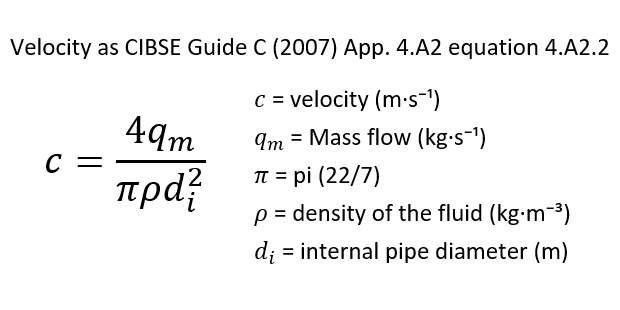When sizing heating and chilled water pipework, the maximum water velocity should be limited to avoid noise and prevent erosion or corrosion damage occurring and the minimum water velocity should be sufficient to prevent suspended matter settling out leading to system deterioration.
Maximum Velocity
CIBSE updated their guidance on maximum velocities in water pipes in Guide B1 (2016) Table 1.A1.4 to match BSRIA’s Design Checks for HVAC (BG 4/2007) document. Preference would be to use the figures in Table 1.A1.4 for pipe sizing rather than values stated in CIBSE Guide C (2007) Table 4.6 as Guide B differentiates between copper and steel; copper is softer than steel therefore more prone to erosion as velocity increases.
The limiting water velocities stated in CIBSE B1 (2016) Table 1.A1.4 for copper pipes between 15-50 Ø should not exceed 1.0 m·s⁻¹ and >50 Ø should not exceed 1.5 m·s⁻¹. Steel pipes between 15-50 Ø should not exceed 1.5 m·s⁻¹ and >50 Ø should not exceed 3.0 m·s⁻¹.
Additionally, as pressure rises with an increase in velocity, CIBSE B1 (2016) Section 1.A1.3 recommends that pipes should be sized based on a criterion of not exceeding 200 Pa·m⁻¹, and thereby limit the water velocity, to minimize the life cycle energy consumption of a pipework system.
Summary of maximum velocities:
Copper 15-50 mm ≤1.0 m·s⁻¹, over 50 mm ≤1.5 m·s⁻¹
Steel 15-50 mm ≤1.5 m·s⁻¹, over 50 mm ≤3.0 m·s⁻¹
Minimum Velocity
Full load design minimum velocities should be maintained at greater than 0.5 m·s⁻¹ for air and dirt displacement (CIBSE B1 (2016) Section 1A1.3.1).


Comments are closed.